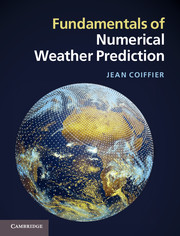Book contents
- Frontmatter
- Contents
- Foreword to the French Edition
- Foreword to the English Edition
- Preface
- Acknowledgments
- Partial list of symbols
- 1 Half a century of numerical weather prediction
- 2 Weather prediction equations
- 3 Finite differences
- 4 Spectral methods
- 5 The effects of discretization
- 6 Barotropic models
- 7 Baroclinic model equations
- 8 Some baroclinic models
- 9 Physical parameterizations
- 10 Operational forecasting
- Appendix A Examples of nonhydrostatic models
- Further reading
- References
- Index
- Frontmatter
- Contents
- Foreword to the French Edition
- Foreword to the English Edition
- Preface
- Acknowledgments
- Partial list of symbols
- 1 Half a century of numerical weather prediction
- 2 Weather prediction equations
- 3 Finite differences
- 4 Spectral methods
- 5 The effects of discretization
- 6 Barotropic models
- 7 Baroclinic model equations
- 8 Some baroclinic models
- 9 Physical parameterizations
- 10 Operational forecasting
- Appendix A Examples of nonhydrostatic models
- Further reading
- References
- Index
Summary
Introduction
The finite difference method is very widely used for numerically solving partial differential equations in science in general and in fluid mechanics in particular because it is simple to implement. In fact, it was the method Richardson (1922) used for the first attempt at weather forecasting by hand calculation. While methods using series expansion in terms of functions now compete with the finite difference method for the horizontal processing of meteorological fields, vertical discretization, to some extent, and time discretization still utilize finite differences. This presentation of finite differences is not designed to demonstrate the basic results that can be found in books on numerical analysis but rather to show in concrete terms how the finite difference method is applied to numerical weather prediction models.
Computational principle, order of accuracy
The finite difference method consists in evaluating the partial derivatives of a function at one point from the differences between the values of that function at adjacent points. This procedure can be applied systematically insofar as a given continuous field is known in a discrete way. The values of the field to be processed are determined at the nodes of a regular grid (for example, rectangular grid for a two-dimensional field) characterized by its mesh size (∆x, ∆y), applied over the spatial domain for which solutions are sought.
- Type
- Chapter
- Information
- Fundamentals of Numerical Weather Prediction , pp. 39 - 56Publisher: Cambridge University PressPrint publication year: 2011



